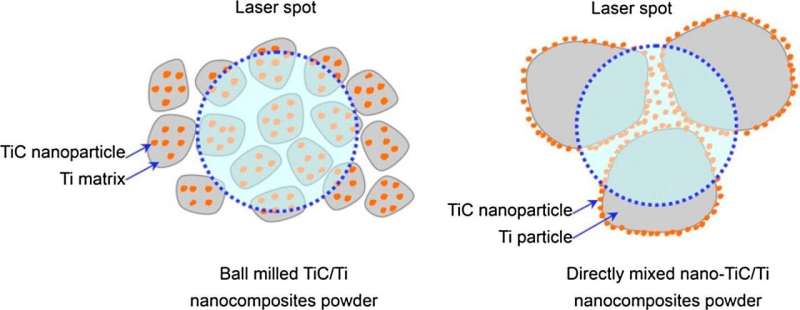Researchers' review paper reveal insights into high quality fabrication of nanocomposites

Metal matrix nanocomposites (MMNCs) are increasingly used in industries such as automotive, aerospace and military due to their excellent combination of high strength, thermal stability, ductility and isotropy. However, despite MMNCs' superior properties and growing interest, the complex processing and inadequate economic efficiency have limited the applications of MMNCs. High energy consumption is still essential to disperse the reinforcement to achieve microstructural homogeneity and advanced mechanical properties in these materials.
Selective laser melting (SLM), also known as laser powder bed fusion (L-PBF), is an additive manufacturing (AM) technology applied to metals and ceramics, and has shown promising potential for fabrication of unique structures and properties such as MMNCs. Using high power laser, SLM allows for quick production of three-dimensional (3-D) parts with complicated shapes directly from powder materials without the time-consuming mold design process. This reduces production cost and lead time while delivering customized MMNCs parts for automotive, aerospace, electronics and biomedical industries.
However, due to the lack of comprehensive understanding of the defects unique to SLM as well as the fabrication and performance of nanocomposites with SLM, researchers from Singapore University of Technology and Design (SUTD) and their research collaborators set out to gain a thorough understanding of the scientific and technological knowledge. They reviewed state of the art research from the perspective of materials and SLM processing parameters. Their paper was published in Progress in Materials Science, a journal that publishes authoritative reviews of recent advances in the science of materials.
An in-depth review of the fabrication considerations related to nanocomposites was also conducted including the materials and SLM processing parameters, emphasizing physical properties and preparation of powders (refer to image). Thereafter, mechanical properties of MMNCs and the corresponding enhancing mechanisms were addressed to provide a deeper understanding of MMNCs.
"MMNCs have always been a huge interest for material scientists. With the advancement in advanced manufacturing, particularly additive manufacturing, there is now greater potential in achieving high quality MMNCs. In our review, laser powder bed fusion is chosen as the process in focus as it has proven its capabilities in fabricating functional parts from metals and ceramics," explained principal investigator and co-author Professor Chua Chee Kai from SUTD.
The review paper also addressed the defects unique to SLM technology associated with nanoparticles. The applications of MMNCs especially those fabricated with SLM processing were also listed and compared.
"One of the key challenges in AM is the lack of 'printable' materials. We believe this comprehensive review provides a timely overview and understanding of SLM for MMNCs by focusing on the merits while not ignoring the limitations. This hopefully will encourage more researchers to explore this highly interesting area," said co-author Dr. Sing Swee Leong from Nanyang Technological University.
More information: W.H. Yu et al, Particle-reinforced metal matrix nanocomposites fabricated by selective laser melting: A state of the art review, Progress in Materials Science (2019). DOI: 10.1016/j.pmatsci.2019.04.006
Provided by Singapore University of Technology and Design




















